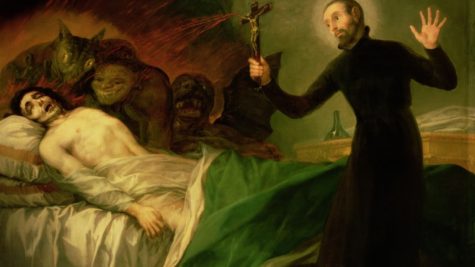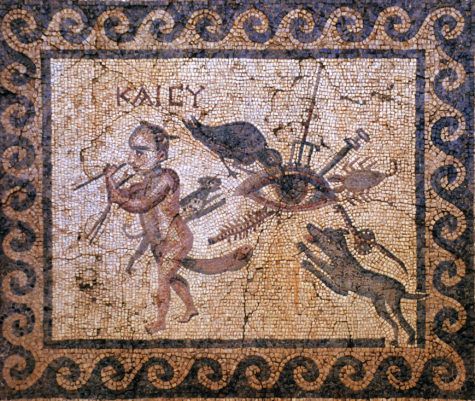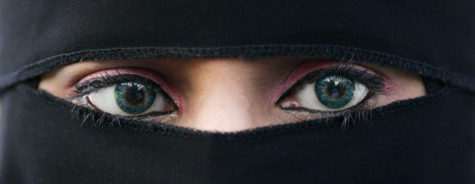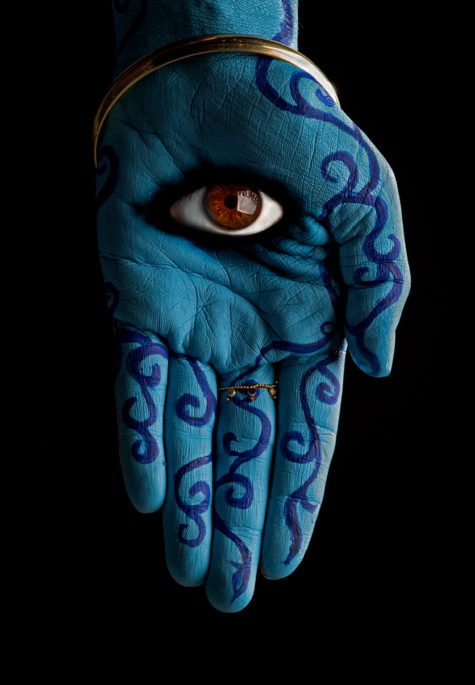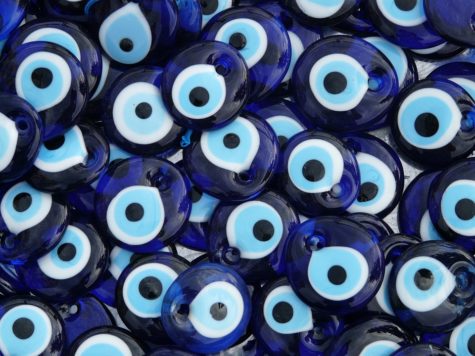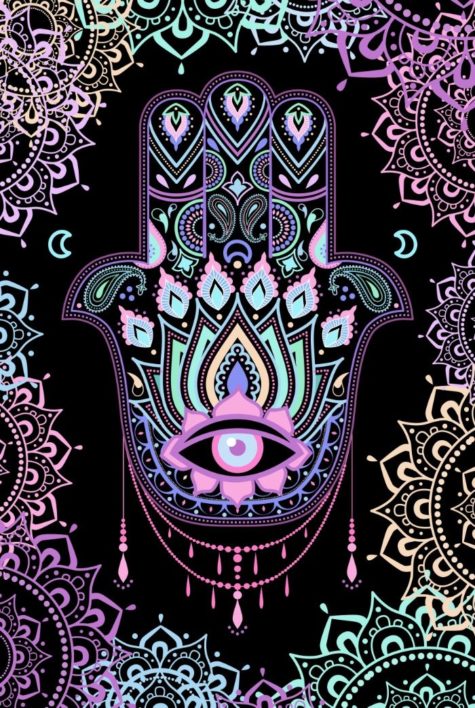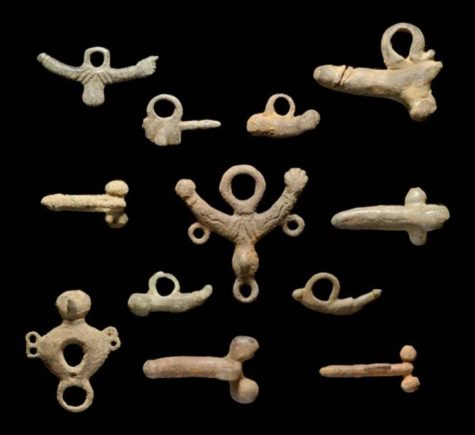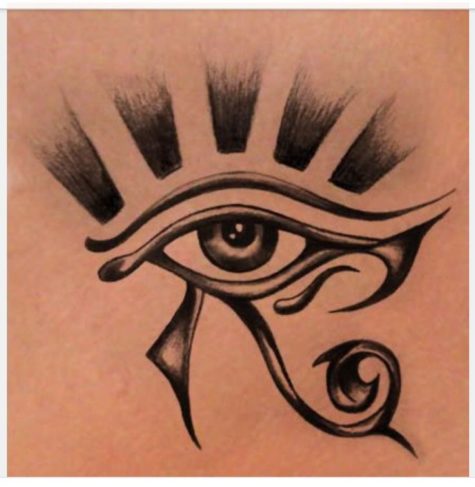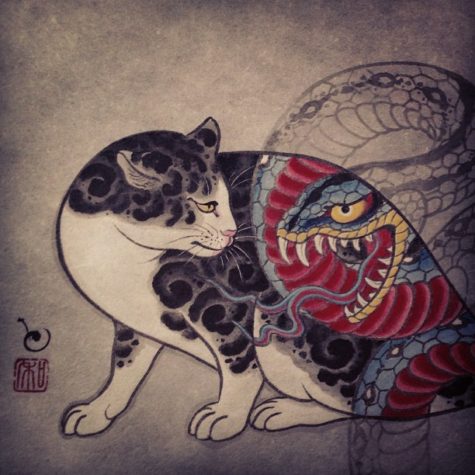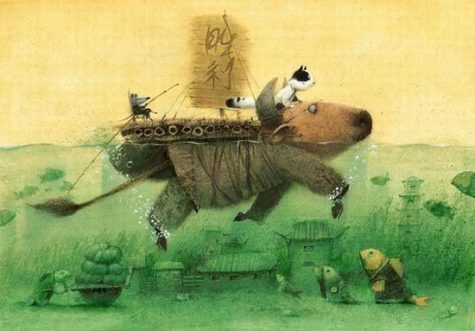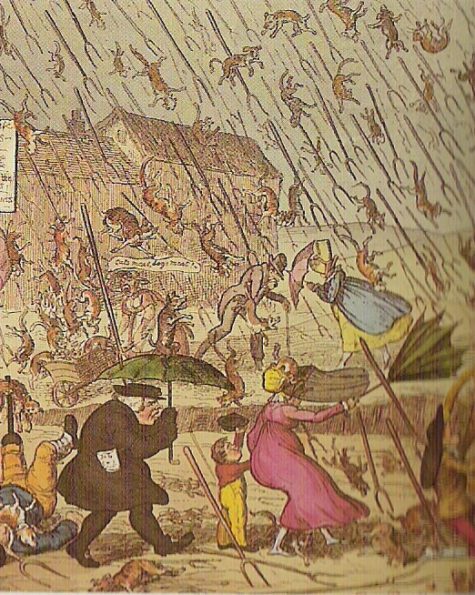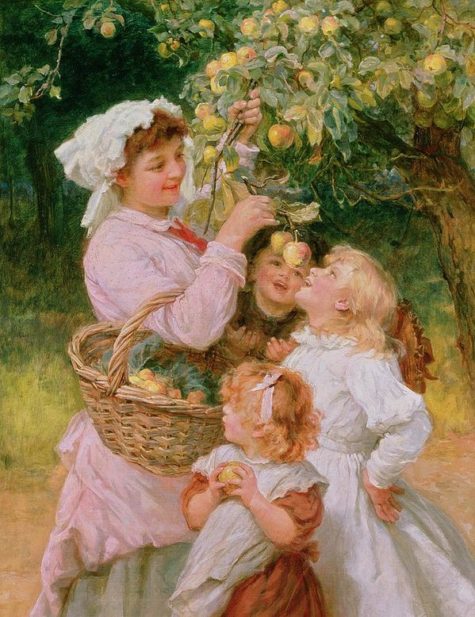Yearly Archives: 2017
Bad Omens In Nebraska
The signs, omens, and portents in the following collection have been reported by inhabitants of Nebraska and most of them are beliefs or sayings commonly known in the central western region. Although the list must be far from complete, it is probably representative of the bulk of current (1933) superstitions of Nebraskans.
- If a dog howls at night, it is a sign of the death of a friend.
- If a dog sits and howls at the moon, it is a sign of death.
- One death will be followed almost immediately by two more in the family or the neighborhood.
- If a bird flies into the house, it is a sign of a death in the family.
- If an owl hoots near the house, some one in the house will die within a short time.
- If an owl hoots three times on the property of anyone, it is a sign that there will be a death in the family of the person who owns the land.
- If you hear an owl hoot at night, you will soon hear of the death of a friend.
- If a loaf of bread be found upside down, there will be a death in the family.
- If a light on the order of a will-o’-the-wisp passes around the house, it is the sign. of a death in the house within a short time.
- If a mirror falls, there will be a death in the family.
- If you break a mirror, there will be a death in the family within a year.
- If two people in a family die within a year, a third death will occur before the year is out,
- If a child is unusually bright and good, it will die.
- If a cock crows at midnight, it is a sign that the death angel is passing overhead.
- If you sneeze before breakfast on Sunday morning, you will hear of a death before the end of the week.
- If lighted candles are placed at each plate, the person at whose place the candle burns longest will live longest, the one whose candle goes out first will be the first to die.
- If a bird pecks at the window of a home, it’ is a sign of a death in that family within a year.
- If a ticking sound is heard in the wall, a death may be expected in the family.
- A sparrow flying around the house is a sign there will soon be three deaths in the family.
- If you meet a funeral, there will be a death in the family.
- The first person the cat looks at after washing its face will die soon.
- If it rains into an open grave, another member of the family will die within a year.
- If a baby cuts its upper teeth first, it is digging its own grave; that is, it will soon die.
- If you look into a mirror at a funeral, you will be dead before the end of a year.
- If three lights are accidentally placed on the table, it is a sign of a death in the family before the end of the year.
- To carry a pan of coals through the house is a sign that there will be a death in the family.
- Carrying a spade through the house forebodes a death.
- A spade, a hoe, or a shovel should not be brought into the house. If they are, there will be a death in the family.
- To carry a sharp instrument through the house is a sign of a death in the family.
- If you open an umbrella in the house, some one in the family will die soon.
- If you count the cars of a freight train, some one in your family will die.
- If you count the number of carriages in a funeral procession, some one in your family will die soon.
- If a person counts the number of cars in a funeral procession, he will cause a death in his family within a month.
- After a funeral the first person to leave the graveyard will be the first to go back; that is, to die.
- If you cross in front of a funeral procession, there will be a death in the family.
- A funeral on Sunday means another death in a short time unless a wedding follows the funeral.
- If you knock at your own door, some one in the family will die.
- If a baby under a year old sees itself in a mirror, it will die before the year is over.
- If you pass anyone on the stairs going in the opposite direction, there will be a death in the family.
- If all the members of the family are not home at Thanksgiving, there will be one death in the family before the nest Thanksgiving.
- If a child is named for someone who is dead, he will die young.
- A green Christmas makes a black graveyard.
- To rock an empty rocking-chair forebodes a death.
- If you break a needle while making a garment, you will hear of a death before the garment is worn out.
- If a hen crows, there will be a death in the family.
- To grieve over the death of a pet is a sign of a death in the family.
- If a funeral procession crosses your path, you will have bad luck.
- If it rains during the funeral procession, the relatives of the deceased will have bad luck.
- It is bad luck to cross between the carriages of a funeral procession.
- If a tug comes unhooked going to the grave, it is a sign of bad luck.
- It is bad luck to count the cars in a freight train.
- It is bad luck to turn around in a car, if you are a member of the funeral party.
- Friday the thirteenth is an unlucky date.
- It is bad luck to begin a job on Friday.
- If a garment is begun on Friday, you won’t live to wear it out.
- If a garment is begun on Friday, you won’t live to finish it.
- Never cut out a garment on Friday, unless you finish it that day. Otherwise you will have bad luck.
- It is bad luck to set out on a journey on the thirteenth.
- If you break a looking glass, it means bad luck for seven years.
- Don’t sweep dust out of the door on Monday. It brings bad luck.
- You must not sweep with a broom across the threshold after dark or you will sweep away your luck.
- If you sweep dust over the threshold after dark, you are sweeping away your wealth.
- Don’t sweep dust out of the door on New Year’s day. It is bad luck.
- It is bad luck to move a broom.
- When sweeping the floor, don’t brush the broom against any one else or it will bring that person the worst of luck.
- It is bad luck to carry ashes out after sundown.
- It is bad luck to carry a hoe through the house.
- Carrying a garden tool through the house is a sign of ill luck.
- If you drop a fork, you will have bad luck.
- If you drop a knife, you will have bad luck.
- It is bad luck to spill the salt.
- It is bad luck to have a picture hanging crooked in the house.
- It is bad luck not to have the Christmas tree down by January 2.
- It is bad luck to rock an empty chair.
- It is bad luck to watch a person out of sight.
- It is bad luck to tell any one “good luck”.
- Never walk under a ladder. It is the worst of luck.
- It is bad luck to shut an open gate as you pass by.
- If you see the moon over your left shoulder, you will have had luck.
- It is bad luck to carry a two-dollar bill.
- If you pick up a pin with the head toward you, you mill have bad luck.
- The opal brings misfortune except to those born in October.
- If the first person to enter your house on New Year’s day is a woman, you will have bad luck for the year.
- If Christmas day on a Sunday fall, A troublous winter we shall have all.
- Wearing pearls is a sign of sadness or misfortune.
- It is unlucky to seat thirteen people at the table.
- If you put a garment on wrong side out, Do not change it back all day. For that would drive your luck away.
Found in: Signs, Omens, and Portents in Nebraska Folklore
The Evil Eye
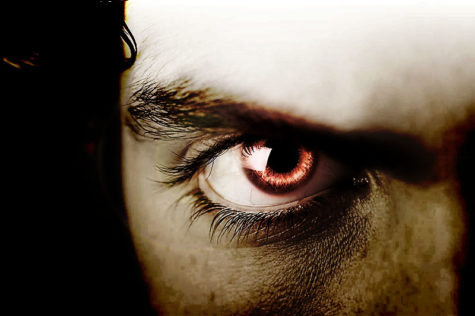
The evil eye is a specific type of magical curse. It is believed to cause harm, illness and even death.The evil eye is a specific type of magical curse. It is believed to cause harm, illness and even death.
Everyone gets a dirty look now and then, and we usually think little of it (especially if we deserved it). For most of us it is soon shrugged off, but in many places belief in “the evil eye” is taken very seriously, and requires immediate action to avoid harm.
The evil eye is a human look believed to cause harm to someone or something. The supernatural harm may come in the form of a minor misfortune, or more serious disease, injury — even death. Folklorist Alan Dundes, in his edited volume “The Evil Eye: A Casebook” notes that “the victim’s good fortune, good health, or good looks — or unguarded comments about them — invite or provoke an attack by someone with the evil eye …
Symptoms of illness caused by the evil eye include loss of appetite, excessive yawning, hiccups, vomiting and fever. If the object attacked is a cow, its milk may dry up; if a plant or fruit tree, it may suddenly wither and die.”
The evil eye is also said to cause a number of other maladies including insomnia, fatigue, depression and diarrhea. In many places, disease is considered a magical as well as a medical issue, and the reason a given person succumbs to a malady may be attributed to a curse instead of random chance or exposure to a virus. It can even affect objects and buildings: The evil eye cast upon a vehicle may break down irreparably, while a house so cursed may soon develop a leaky roof or an insect infestation. Just about anything that goes wrong may be blamed on the power of the evil eye.
The evil eye is essentially a specific type of magical curse. Let’s say that a person experiences bad luck, ill health, accident, or some unexplained calamity — perhaps a drought or an infectious disease. Before science could explain weather patterns and germ theory, any bad event for which there was not an obvious cause might be blamed on a curse. Curses, including the evil eye, are an answer to the age-old question of why bad things happen to good people.
Evil eye in history
The evil eye is well known throughout history. It is mentioned in ancient Greek and Roman texts, as well as in many famous literary works, including the Bible (such as Proverbs 23:6: “Eat thou not the bread of him that hath an evil eye, neither desire thou his dainty meats”) the Koran and Shakespeare’s plays. Though belief in the evil eye is widespread, it is not universal. A 1976 cross-cultural survey by folklorist John Roberts found that 36 percent of cultures believed in the evil eye.
The earliest known evidence for belief in the evil eye goes back to ancient Greece and Rome. It was believed that the evil eye was the largest threat to anyone who had been praised too much, or received admiration beyond what they truly deserved. The praised person would become so swollen with pride that he or she would bring about his or her own doom via the evil eye, which was believed to be able to cause physical and mental illness. In fact, any disease which did not have an immediate, obvious cause was thought to be caused by the evil eye. It was thought that the gods and goddesses were punishing those who had become too proud of their achievements, and destroyed them with the power of the evil eye to restore them to the level of mere mortals.
The symbol and superstition of the evil eye is one of the strongest symbolic images in the world. Yet, despite the differences in the cultures which hold the evil eye myth, it retains largely the same meaning no matter where the story is told. The evil eye is thought of as a look given to inflict harm, suffering, or some form of bad luck on those that it is cast upon. It is a look which clearly states that one intends for something bad to happen to the object of one’s focus, either out of jealousy or pure malice. The superstition of the evil eye holds that the malicious look is powerful enough to bring about actual disaster for the unfortunate person that is the receiver of the glare.
Eyes are said to have special powers; they are said to be the gateway to a person’s soul.
The evil eye is a powerful superstition in India. Hinduism preaches that the eye is the most powerful point at which the body can give off energy. Thus, a strong fear of an “evil” look from the eye makes sense; the evil eye holds enormous powers. The Hindus fear that even an “admirable” eye can bring about ill luck, resulting in the supply of milk from cows drying up (again, this idea dates back to the fear of undue praise, first warned against in Greece). In fact, the Hindus will offer the “admiring” glancer a bowl of milk to counteract the threat of the evil eye.
The Hindus also believe that jealousy is at the root of the power of the evil eye, whether in the form of a malicious or admirable look. Interestingly, the Hindus teach that the times of change in life–as in during puberty, marriage, or childbirth–one is most vulnerable to the threat of the evil eye.
Hindus believe that even animals such as the snake are capable of giving one the evil eye. They believe that, even though men are capable of casting the evil eye, women are the most common sources of the glance. For this reason, in South India women will paint their eyelids black to protect themselves from the evil eye, and to prevent themselves from eyeing another with the look.
In South America, Brazil holds a superstition equivalent to the evil eye known as the “fat eye.” Compliments which are sincere are not feared to cause the evil eye to attack as in other countries, but insincere compliments are thought to put one at stake.
In Europe, the myth of the evil eye also originated with the idea that envious or malicious looks had the power to bring about bad luck. The largest source of the evil eye was believed to be witches. Yet those with eye colors which were rare were also seen as powerful possessors of the evil eye look. For instance, Germans feared those with red eyes. In Ireland, those with squinty eyes were feared to be evil eye sorcerers. In Italy, the unibrow was another sign that one would cast an evil eye.
Shifting eyes are said to subtly betray liars, while a steady gaze may be endearing or menacing depending on the circumstances. Eye contact can create an intensely personal connection, whether between lovers or superiors and subordinates. Glaring or intense staring can convey power and authority over another. And of course, actors use their eyes to convey a wide range of emotions, including love, hate, disgust, boredom, scorn, surprise and envy. In fact it is this last emotion — jealousy — that underlies the evil eye’s cultural association with magic.
Belief in the power of the eyes is so powerful that any eye affliction has come to suggest evil and bad luck. People who are cross-eyed, have uncontrollable eye twitches or spasms (a condition called blepharospasm), or who merely have a prominent squint have been shunned and feared as provoking bad luck, especially among those who work in dangerous occupations such as fishing and mining. Similarly, those with unusually close-set eyes or eyes of different colors were often suspected of having the evil eye.
Babies and children are said to be especially susceptible to harm from the evil eye, and in many countries, including Greece, Romania, and India, praising a child publicly is sometimes considered taboo, for the compliment will draw the attention of the evil eye. In order to ward off the evil eye, parents of a thoughtlessly praised child may ask the person who gave the compliment to immediately spit in the child’s face. Because the momentarily exalted youngster has been brought down a peg, any harm by the evil eye is unnecessary; this spittle salve is harmless yet insulting enough to negate the compliment.
The fear of the evil eye did not carry over to America, except in the form of a metaphor. While the superstition is not intense enough to take precaution, the evil eye is seen as impolite, and a warning that the source of the evil eye has bad intentions.
Who has the evil eye? Maybe you do. Many believe that bad intention is not necessary, and that some people can cast an evil eye without even knowing it. If one person is believed to have the evil eye, other members of his or her family are often treated with suspicion — and any children are assumed to have the curse as well.
Methods of Protection against the Evil Eye
The best way to deal with the evil eye is to avoid it in the first place. The method varies by culture, geographic region, and personal preference. In Puerto Rico, for example, newborns are often given a good luck charm called an azabache to protect them from the evil eye.
In addition to the use of evil eye amulets, the Greeks would carry incense or the cross as protection against the evil eye. New mothers would keep objects as protection under their pillows or on their heads, and these included red, black, or white strings, a nail, gunpowder, bread, salt, garlic, a ring, indigo blue, or a pair of silver buckles. Each of these objects held a meaning which made it a good defense against the evil eye. For instance, gunpowder symbolized an ability to fight back against the evil eye. The nail symbolized strength. The indigo held its power in its blue coloring. Salt was a symbol of preservation and strength.
Amulets can be worn to deter the evil eye, often using the color blue (symbolizing heaven or godliness) and an eye symbol. Charms, potions and spells can also be prepared; garlic can be used to deter the evil eye, and some believe that just saying the word “garlic” offers protection.
The most popular method of escaping the evil eye’s effects in many cultures is by the use of evil eye talismans, evil eye symbols, and evil eye jewelry. These are meant to “reflect” the power of the evil look. The evil eye amulet originated in Greece, where it was known as an “apotropaic” amulet, meaning that it reflected harm.
The most basic design of the evil eye, prevalent in the Middle East, is a talisman designed with concentric blue and white circles made to symbolize the evil eye, known as the nazar. It is often used on houses, vehicles, or jewelry.
One of the most powerful examples of the evil eye amulet in the Middle East and Africa is the Hamsa, also known as the “Hand of Fatima.” The hamsa is a hand-shaped symbol with the evil eye on the palm. The hamsa can be used in wallpaper or jewelry to ward off the evil eye. The hamsa is also found in Jewish culture, where it is known as the “Hand of God” or the “Hand of Miriam.” The popularity of Kabbalah has revived the hamsa and influenced its presence in jewelry and design.
In ancient Rome, the most common amulets were used to avert the influence of the evil eye appears to have been the phallus, called by the Romans fascinum, which was hung round the necks of children. Pliny also says that Satyrica signa, by which he means the phallus, were placed in gardens and on hearths as a protection against the fascinations of the envious; and we learn from Pollux that smiths were accustomed to place the same figures before their forges with the same design.
Sometimes other objects were employed for this purpose. Peisistratus is said to have hung the figure of a kind of grasshopper before the Acropolis as a preservative against fascination Another common mode of averting fascination was by spitting into the folds of one’s own dress.
According to Pliny, Fascinus was the name of a god, who was worshiped among the Roman sacra by the Vestal virgins, and was placed under the chariot of those who triumphed as a protection against fascination; by which he means in all probability that the phallus was placed under the chariot.
Evil Eye Remedies
If these preventative steps failed, however, the Greeks had many more remedies against the evil eye. In some villages, the fur of a bear would be burned to cure the curse. In others, a gypsy would massage the forehead to get rid of the ill effects of the evil eye.
In many countries, including Greece, Armenia, and Assyria, it is thought that a pinch on the rear will remedy the curse of the evil eye. In Europe, some Christians have the tradition of creating the sign of the cross with their hands, while at the same time pointing the index and pinky finger toward the source of the evil eye. In Bangladesh, a black dot is drawn on the forehead of children to ward off the evil eye curse. Pretty young women have a secret dot drawn in kohl behind their ears to protect against the evil eye.
Often those who believe they have been harmed by the evil eye will seek out shamans, witch doctors, psychics or other spiritual healers to remove the curse.
In Latin America the evil eye is known as “mal de ojo,” and belief in it is especially widespread in rural areas. There are several ways to cure mal de ojo; one traditional method from Mexico involves the use of a raw egg. The egg, a universal symbol of purity and birth, is said to absorb evil energies as it passes over the forehead and prone body of the victim. The egg is then broken over a bowl of water and the resulting forms closely examined for any unusual shapes. An oval or eye shape seen in the yolk or whites is said to indicate that the evil eye’s power has been successfully removed from the victim. Some claim that the gender of the person who cast the evil eye can be determined from the shapes.
In different languages, the evil eye is known as:
- Arabic – Ayin Harsha
- Farsi – Bla Band
- France – Mauvais Oeil
- Germany – Böser Blick
- Hebrew – Ayin Ha’ra
- Italian – Mal Occhio
- Romans – Oculus Malus
- Scotland – Droch Shuil
- Spanish – Mal Ojo or El Oja
- Turkish – Nazar Boncugu
The Evil Eye Today
It is tempting to view the evil eye as an ancient, discredited belief that plays no role in our 21st-century world. Instead, as folklorist Dundes notes, we “should keep in mind that the evil eye is not some old-fashioned superstitious belief of interest solely to antiquarians. The evil eye continues to be a powerful factor affecting the behavior of countless millions of people throughout the world.”
The evil eye still has powerful influence in modern life, pop culture, and even jewelry and design. Who is not familiar with the phrase “the evil eye,” or thought to have caught someone casting it their way at least once or twice before? In Turkey, the Evil Eye is ingrained in every day life and has deep symbolism throughout the culture. The Evil Eye pendant is affixed to anything that is perceived to attract greed, envy, or ill-will. In Turkey, you will find the Evil Eye symbol on currency, in homes and offices, hanging from the necks of newborn children and farm animals, and in the foundations of buildings.
Though belief in the evil eye can be a harmless superstition, it can also be dangerous in some circumstances. Any time one person believes that another has harmed them — whether naturally or supernaturally, intentionally or accidentally — there is the potential for deadly retribution. Like other accused witches and sorcerers over the centuries, many people have been attacked, beaten, and killed for casting an evil eye.
From: Live Science and other sources
Blackberry Kittens
In Sussex, and some other counties in England, a kitten born just after Michaelmas (September 29), when the blackberry season has ended, is called a blackberry-cat and is expected to be extremely mischievous in its youth.
The same tradition applies to other young animals born at this time, and seems to be connected with the legend of the Devil’s fall to Earth at Michaelmas and his spoiling of the blackberries then and ever since.
Source: The Encyclopedia of Superstitions
Cat Symbolism and Lore
Even the most common household cat has a mystique about it and the potential for the supernatural powers that man has ascribed to cats for thousands of years.
At various times, and in different places, it has been regarded as a holy or a diabolical beast, as a bringer of good fortune or as an omen of evil. In antiquity it was sacred to more than one divinity.
Artemis / Diana, the Goddess of the Hunt was associated with the cat, also notorious for its hunting skills. The followers of Diana revered cats because they were under her special protection, and because she once assumed that form. So too, in pagan Scandinavia, Freya, the goddess of love and fertility, was associated with them, her chariot was drawn by them.
Typically, in Western civilizations, the cat (particularly if it is black) belongs to the witch; it is her familiar, her companion and her alter ego. As such, the cat shares magickal secrets and arcane knowledge which, of course, she cannot explain to mere mortals, since they don’t speak her language. There is an unspoken communication between the witch and her grimalkin that transcends any language used by other creatures.
In the Saga or Eric the Red, there is a very complete description of a witch or prophetess that was a mistress of rune-craft, the art of reading the runes. Part of the description of her costume includes a hood “lined with white cat skin” and “cat-skin mittens.”
When it sleeps, the cat curls itself into a circle with its head touching its tail, making a shape that is very similar to the ouroboros. Like this ancient mythical creature, the cat is a symbol of immortality.
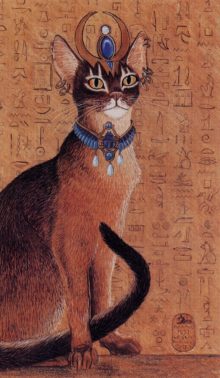 The Ancient Egyptians regarded the cat so highly that they revered it as a deity. The Egyptian Bast, or Pasht, was cat-headed and attended by cats, and consequently every member of the cat family was loved and venerated in ancient Egypt. To kill one was sacrilege. When a household pet died, its owner shaved off his eyebrows as a token of mourning and performed funeral rites for it.
The Ancient Egyptians regarded the cat so highly that they revered it as a deity. The Egyptian Bast, or Pasht, was cat-headed and attended by cats, and consequently every member of the cat family was loved and venerated in ancient Egypt. To kill one was sacrilege. When a household pet died, its owner shaved off his eyebrows as a token of mourning and performed funeral rites for it.
Bast was the cat goddess, and mortal cats whose fur was of three different colors, or who had eyes of different shades were honored in particular for their Bast-like appearance; it is not just the black cat that holds power. Bast is often depicted with a knife in her paw, having beheaded Apophis, the enemy of the Sun.
Egyptian priests believed that cats carried the magnetic forces of nature and so close proximity to the creatures enabled them to access these powers. If a cat died a natural death in the home, the Egyptians would shave their eyebrows as a sign of mourning.
It was in ancient Egypyt that the belief began that a black cat crossing your path brings good luck. The opposite tradition began in the Middle Ages in Europe.
Cats fared badly during the dark times of the Middle Ages because of the association between witches and cats. Black cats were believed to be witches in disguise. An alternative belief was that after seven years of service to a witch, a black cat would turn into a witch. Consequently, a black cat crossing your path was an indication of bad luck, as the devil was watching you.
The cat does not an honorable reputation in the Buddhist tradition either. Because it was absent at the physical death and spiritual liberation of the Buddha, it is viewed with suspicion as a base, earthly creature, lacking respect, which really should have been present at such an auspicious occasion. The only other creature that was not there was the serpent.
The link between the cat and the serpent comes in the Kabbalah, too, and also in Christianity; in pictures where the cat appears at the feet of Christ it carries the same negative imagery as the snake.
In Islam, cats are regarded favorably unless they are black, in which case they are viewed with great suspicion since djinn can transform themselves into black cats. Additionally, the magical powers of the cat are ambivalent, used either for or against man, this refers to the indifference with which a cat treats its prey.
In the Western tradition of cat lore, the animal has nine lives, whereas its Eastern cousin has to manage with only seven.
A Persian belief about the cat echoes the idea of the witch with her familiar. Some people are born with a hemzad, a spirit that accompanies the person throughout his or her life and takes the form of a cat. That its blood is particularly powerful for writing charms further underlines the universally “magical” nature of the cat.
In Africa, too, the clairvoyant powers of the animal are renowned, and so medicine bags made of cat skin are imbued with supernatural powers.
Interestingly, the cat is not in the Chinese Zodiac. One folktale explanation is that heard Buddha saw Cat playing with mice for fun and did not allow that kind of sin into the zodiac.
Another folk story tells that Cat and Rat were the worst swimmers in the animal kingdom. Although they were poor swimmers, they were both quite intelligent. To get to the meeting called by the Jade Emperor, they had to cross a river to reach the meeting place. The Jade Emperor had also decreed that the years on the calendar would be named for each animal as they arrived to the meeting.
Cat and Rat decided that the best and fastest way to cross the river was to hop on the back of Ox. Ox, being naive and good-natured, agreed to carry them both across. Midway across the river, Rat pushed Cat into the water. Then as Ox neared the other side of the river, Rat jumped ahead and reached the shore first. So he claimed first place in the competition and the zodiac.
Collected from various sources
Raining Cats and Dogs
Where does the expression “Raining Cats and Dogs” come from?
Some authorities tie the idea to Norse mythology. Odin, the Viking god of storms, was often pictured with dogs and wolves, symbols of wind. Witches, who supposedly rode their brooms during storms, had black cats, which became signs of heavy rain. Therefore, “raining cats and dogs” referred to a storm with wind (dogs) and heavy rain (cats).
While the story sounds good, the expression didn’t become popular until the 1700s, when Jonathan Swift (author of Gulliver’s Travels) used it in a satire. He pictured snobby upper class aristocrats solemnly fretting that it would “rain cats and dogs”. Suddenly the saying caught on. Apparently, the English spent a lot of time chatting about rain and it was the latest hit phrase.
More recently, this bit of contemporary “folklore” distributed in a hoax email put forth the following idea, which has since been disproved:
In the 1500’s, houses had thatched roofs – thick straw, piled high, with no wood underneath. It was the only place for animals to get warm, so all the pets… dogs, cats and other small animals, mice, rats, bugs lived in the roof. When it rained it became slippery and sometimes the animals would slip and fall off the roof. Hence the saying, “It’s raining cats and dogs.”
Source: Almanac.com
Apple Tree Symbolism and Lore
The apple tree seems to have been regarded as holy or magickal from very early times, and in almost every country in which it grows.
In ancient Ireland, it was one of the three things that could only be paid for by living objects, the others being a hazel bush and a sacred grove.
For Celtic people, the apple tree symbolized the World Tree, the axis of the Universe. They considered the apple the most magickal of fruits, a fruit of immortality and prophecy.
It grew in the Celtic Paradise, where the hills were clothed with trees that bore fruit and blossom together. The mysterious land to which King Arthur was taken for the healing of his wounds was the Vale of Avalon, the Apple Vale. The mythical Isle of Avalon, meaning orchard (from afal, the old Welsh word for apple) is the resting place of Celtic kings and heroes, and one of the places where King Arthur is meant to wait until he is needed to rise once more to protect his people.
The apple tree is a tree of the Underworld, a tree of immortality, and sacred to Apollo. At Samhain or Halloween, the time of the apple harvest, the fruit has a large part to play in the rituals and celebrations, including divinatory practices.
Old laborers in Herefordshire regarded the destruction of an apple orchard as an almost sacrilegious act. It was commonly said there that if an orchard was destroyed to plant a hop yard in its place, the latter would never pay the cost of cultivation.
At that time there was also a custom whereby, if a man wanted to enclose a piece of common land, he had to plant an apple tree on it. The lord of the manor preserved his rights over the enclosed land by extracting an annual tribute of the fruit.
Many omens and charms are, or were, associated with apple trees. Here are some of them:
- If the sun shines through the trees on Christmas morning (or in some districts on Easter morning) is is a sign of a good crop to come and a prosperous year for the owner of the orchard.
- The fruit must be blessed by rain on St. Peter’s or St. Swithin’s Day, and in some districts it is said to be unfit to eat until after this has happened.
- Blossoms appearing in autumn is a death omen for someone in the owner’s family, and especially so if the flowers come while there is still fruit on the branches.
- A well known couplet says:
A bloom on the tree when the apples are ripe
Is a sure termination of somebody’s life.
If, when the fruit is picked, an apple is left behind and hangs there until Spring comes round again, a death is foretold.
There was, however, a Yorkshire variant of this belief. In his Folk-Lore of East Yorkshire (1890) John Nicholson tells us that it was sometimes thought unlucky to strip the tree completely. An apple or two, even if only the deformed or inaccessible fruit, should be left for the birds. This was the explanation given in his time but, as he points out, the gift may originally have been intended for the fairies, and some even older spirits.
Collected from various sources.
Adams Apple
The Adam’s apple is actually a protruding piece of thyroid cartilage that develops at puberty, but only in the male. It is so-called because it is said to symbolize the piece of the apple of knowledge that got stuck in Adam’s throat after Eve, encouraged by the serpent, coaxed him into eating the fruit.
The Adam’s apple can be a bit of a pain in the neck for transsexuals, cross-dressers, and female impersonators, since it can be the one giveaway sign that the apparently well-dressed lady is in fact a gentleman. The offending lump can, however, be removed by surgery.
From: The Element Encyclopedia of Secret Signs and Symbols
Apple Symbolism and Lore
 The apple, that infamous fruit said to have been given by Eve to Adam, is a symbol of sexual awakening, and has deep associations with magick.
The apple, that infamous fruit said to have been given by Eve to Adam, is a symbol of sexual awakening, and has deep associations with magick.
If an apple is cut in half across its “equator” then the pattern of the seeds is revealed, a perfect five-pointed star or pentagram. The repercussions of this hidden magickal symbol are far-reaching. Five, comprised of the feminine number 2 and the masculine number 3, is the number of harmony, of the union of opposites (for example in sexual congress), and of marriage. It is also the number of humankind because of the five points of extremity of the human body.
When Eve gave Adam the Apple of knowledge in the Garden of Eden, therefore, it was not just a piece of fruit she was offering him, but a potent symbol of wisdom. Eating the fruit that contains the pentagram resulted in a profound awakening for Adam and Eve. They became not only aware of their own sexual natures, but they realized that they could make their own choices.
Here the pentagram stands for the spiritual nature of man, and eating it awakens Adam to new possibilities; the flesh combines with the spirit, and immediately Adam and Eve cover their genitals, signifying sexual awakening.
Note: The Bible does not actually identify the fruit eaten by Adam and Eve. Eve took “the fruit of the tree which is in the midst of the garden” ~Genesis 3:3. This fruit is more likely to have been a fig than an apple, as Adam and Eve both covered themselves with fig leaves after tasting the fruit.
In Gypsy wedding ceremonies it is customary to cut the apple in the way described above, the bride and groom each eating half of the fruit.
According to Greek legend, Dionysus, the god of the fertility of nature, created the apple as a gift for Aphrodite, the goddess of beauty. This is the opposite of the Bible story, as in this case the man gave the apple to a woman.
When Zeus and Hera got married, Gaia, Mother Earth, gave the bride golden apples to symbolize fertility. These apples of fertility later became Hercules’ eleventh labor, when he had to steal them and bring them back home. These apples provided immortality to anyone who tasted them.
These stories and others, gave the apple its erotic connotations. Consequently, it’s not surprising that Christians considered the apple tree a tree of sin. The phrase “apple of one’s eye,” which indicates a favorite, well-loved person, may have come from this.
The 19th century proverb, “An apple a day keeps the doctor away,” may have had its beginnings in Norse legend, because the gods retained their vitality and health by eating apples from the gardens of Asgard.
In mythology and folklore, apples have power in addition to taste:
- a means to immortality
- an emblem of fruitfulness
- an offering
- a distraction in suitor contests
- a means of divination
- a test of chastity
- a love charm
- a magic object
- a cure
Magickal apples that confer immortality can be plucked from mythological trees all over the world, In Scandinavian stories, perpetual youth apples were kept by Idun in Asgard, and guarded by the Goddess. Their purpose was to keep the Gods youthful until the end of the Universe.
The Hesperides, in Greek myth, were nymphs that tend a beautiful garden in which grows an apple tree (or trees) whose golden fruit also confer immortality. These apples were understandably highly sought after.
An apple tossed to Conie, son of Conn, by the woman from the Land of the Living provided sustenance to him for a month, but made him long for her and her land, as was her plan.
Gna, messenger of the Scandinavian Frigga, dropped an apple to King Rerir who ate it with his wife, who then bore a child. Frey sent eleven golden apples to Gerda as a marriage offer.
The Greek goddess Atalanta was won by a suitor who threw down golden apples to distract her from their race, which he then won.
In Latin, the word for apple, malam also means “evil,” and reflects the paradox of the apple as a symbol of both good and evil. Although in the Tales of the Arabian Nights, the apple of Prince Ahmed cures all ills, in the fairy tale, Snow White and the Seven Dwarves, the heroine is poisoned by a shiny red apple, and falls into the sleep of oblivion.
The Apple of Discord, inscribed For the Fairest, was given by Paris to Aphrodite, causing a quarrel among the goddesses and helping to bring about the Trojan War.
Collected from various sources
The Banyan Tree
The banyan, or Ficus religiosa, is also known as the vata tree, the bodhi tree, or the Asiatic fig, is one of the trees considered to be the World Tree by the people who revere it. It is considered sacred by the followers of Hinduism, Jainism and Buddhism. In the Bhagavad Gita, Krishna says,
“I am the Peepal tree among the trees, Narada among the sages, Chitraaratha among the Gandharvas, And sage Kapila among the Siddhas.”
This tree is particularly special because the Buddha happened to be sitting underneath one when he was suddenly illumined as to his true nature – the word bodhi means “enlightened.” Although the particular tree under which he was enlightened is no longer living, a cutting was taken in the second century BC by a Sri Lankan princess, and this tree now grows in Anuradhapura in Sri Lanka, where it is the object of pilgrimage. Known as Jaya Sri Maha Bodhi, it is the oldest flowering plant in the world.
Not all Ficus religiosa, (or Banyan trees) can be called a Bodhi Tree. A Bodhi Tree must be able to trace its parent to another Bodhi Tree and the line goes on until the first Bodhi Tree under which Gautama is said to have gained enlightenment.
The banyan can be found anywhere in the world where Buddhism or Hinduism are practiced, and it is often grown near temples. Vishnu, the Hindu God, is often depicted as sitting under a banyan dispensing teachings of philosophy and science to his students.
The tree grows in quite an unusual way with its roots reaching down from its branches which then take hold in the ground. This is why the banyan is sometimes called the “walking tree” or the “tree with many feet.”
The structure of the tree, which is a little like a strange organic building that casts a deep shade, makes it a perfect place to meet, and village councils in India (whose national symbol it is) still meet under these trees to discuss important matters.
The leaves of the banyan move continuously even when the air around is still and no perceptible wind is blowing. This phenomenon can be explained due to the long leaf stalk and the broad leaf structure. However, religious minded people in Hindu/Buddhist religion attribute this movement of the leaves to the fact that “devas” or “gods” reside on these leaves and make it move continuously.
Although it is sacred, it is said to shelter many different kinds of spirits, and so it is considered unlucky to sleep under one at night.
Sadhus (Hindu ascetics) still meditate beneath sacred fig trees, and Hindus do pradakshina (circumambulation, or meditative pacing) around the sacred fig tree as a mark of worship. Usually seven pradakshinas are done around the tree in the morning time chanting “vriksha rajaya namah“, meaning “salutation to the king of trees.”
According to Vedic astrology, the 27 stars (constellations) constituting 12 houses (rasis) and 9 planets are specifically and precisely represented by 27 trees—one for each star. The Bodhi Tree is said to represent Pushya (Western star name γ, δ and θ Cancri in the Cancer constellation).
Sources: Wikipedia
And The Element Encyclopedia of Secret Signs and Symbols
Cotton Threads Around Tree Trunks
 One of the most arresting sights while travelling in India are tree trunks, curiously bound by cotton threads. Most tourists do not see how these threads come to be there and have no idea why they are there in the first place.
One of the most arresting sights while travelling in India are tree trunks, curiously bound by cotton threads. Most tourists do not see how these threads come to be there and have no idea why they are there in the first place.
Let me try to explain.
On certain days of the year, Hindu women will fast and pray for their husband’s long life. As part of the rituals, requesting health and well being of the husband, a married woman walks 108 times around a Pipal tree ( also known as the bodhi tree), tying an unbroken length of cotton thread around its trunk. The women recite prayers as they walk around the tree.
- Why ?
- Why the cotton thread ?
- Why the tree ?
The bodhi tree represents the tree of life. For millenniums, it has supported life of all sorts and for this reason, it is considered to be sacred and must not be cut or harmed in any way.
The cotton thread represents the fragile nature of life, love, trust, faith – and all things that go on to make up a relationship. A single thread may be weak, but, when it is wound 108 times around the trunk, it becomes strong. It is no longer so fragile and no longer easy to break.
By walking around the tree 108 times, the wife contemplates on these matters. Love can only be strengthened by trust, faith and desire to make it work ! With each step, the woman strengthens her relationship with her husband. She prays not just for her husband’s long life, but an enduring relationship that will last beyond this life and into the next.
Of course there are many myths associated with this ritual. The most popular being one where a princess called Savitry who saves the life of her husband by using reverse psychology on the God of Death himself. Using her intelligence, and playing on words, she manages to charm Yama and wins back the life of her beloved husband Satyavan.
Myths aside, the central message of the ritual is, love is tantalisingly weak, yet it can be made strong if you are willing to work on it.
Found at: Bhagwat’s Website

